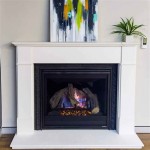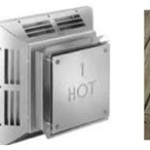Installing a TV into a Stone Fireplace: A Comprehensive Guide
Integrating modern technology, such as a television, into a traditional design element like a stone fireplace requires careful planning and execution. A stone fireplace often serves as a focal point in a room, and mounting a TV above it can be a visually appealing solution for space optimization and creating a comfortable entertainment area. However, the inherent challenges of working with stone, managing heat, and ensuring structural integrity necessitate a thorough understanding of the process. This article provides a comprehensive guide to safely and effectively installing a TV into a stone fireplace.
Before beginning the installation, a detailed assessment of the fireplace and surrounding area is crucial. This assessment must consider several factors, including the type of stone, the structural soundness of the fireplace, the available space, and the intended viewing distance. The weight of the television and the limitations of the stone material must be carefully evaluated to prevent potential damage or hazards.
The type of stone used in the fireplace construction significantly impacts the installation process. Different types of stone possess varying degrees of hardness, porosity, and structural integrity. For instance, granite and marble are known for their density and durability, while softer stones like sandstone and limestone may be more susceptible to cracking or crumbling during drilling. Understanding the specific properties of the stone is essential for selecting appropriate drilling techniques and anchoring systems.
The structural integrity of the fireplace must also be examined. Older fireplaces may have weakened mortar joints or internal damage that is not immediately visible. Inspecting the fireplace for cracks, loose stones, or signs of deterioration is critical. Addressing any structural issues before commencing the TV installation is paramount to ensuring the stability of both the fireplace and the mounted television.
Available space and viewing distance are further considerations that influence the choice of television size and mounting location. A larger television may offer a more immersive viewing experience, but it could also overwhelm the fireplace and detract from the overall aesthetic. The optimal viewing distance is typically calculated based on the diagonal screen size of the television. As a rough guide, the viewing distance in inches should be approximately 1.5 to 2.5 times the screen size.
Selecting the Appropriate Mounting Hardware
Choosing the correct mounting hardware is a critical step in ensuring the safe and secure installation of the television. The mount must be compatible with both the VESA (Video Electronics Standards Association) mounting pattern on the back of the television and the type of stone used in the fireplace. Selecting a mount that is rated to support the weight of the television with a substantial safety margin is imperative.
There are various types of TV mounts available, each designed for specific applications. Fixed mounts offer a low-profile installation, keeping the television close to the wall. Tilting mounts allow for vertical adjustment, which can be helpful for reducing glare or improving viewing angles. Full-motion mounts, also known as articulating mounts, provide the greatest flexibility, allowing the television to be extended, swiveled, and tilted for optimal viewing from different locations in the room.
When mounting a TV above a fireplace, a tilting mount is often recommended to compensate for the higher viewing angle. Tilt can improve the viewing experience and reduce neck strain. The type of mount selected should also permit sufficient space behind the television for ventilation and cable management.
Anchoring the mount securely to the stone requires specialized hardware designed for masonry applications. Expansion bolts, sleeve anchors, and chemical anchors are commonly used for this purpose. Expansion bolts rely on friction to grip the interior of the drilled hole, while sleeve anchors provide a more robust connection by distributing the load across a larger surface area. Chemical anchors use a resin adhesive to bond the anchor to the stone. The choice of anchor depends on the type of stone and the weight of the television. Consulting with a professional installer is advisable to determine the most appropriate anchoring system for a particular application.
Addressing Heat and Cable Management
Heat management is a significant concern when installing a TV above a fireplace. While modern gas fireplaces often produce less heat than traditional wood-burning fireplaces, the heat generated can still damage electronic components over time. Therefore, implementing strategies to mitigate heat exposure is essential for prolonging the lifespan of the television.
The distance between the top of the fireplace and the bottom of the television is a crucial factor in minimizing heat exposure. A general recommendation is to maintain a minimum clearance of 12 inches, but this may need to be increased depending on the fireplace’s heat output. A heat shield or deflector can be installed above the fireplace to redirect heat away from the television. These shields are typically made of metal and can be custom-fabricated to fit the specific dimensions of the fireplace.
Ventilation is another important aspect of heat management. Ensuring adequate airflow around the television helps dissipate heat and prevent overheating. Leaving sufficient space behind the television and avoiding enclosures that restrict airflow is crucial. If necessary, consider incorporating ventilation fans to actively circulate air and reduce heat buildup.
Cable management is also an integral part of the installation process. Wires and cables must be concealed to maintain a clean and organized appearance. Running cables through the wall is the most aesthetically pleasing option, but it requires careful planning and execution. Conduit or cable raceways can be installed to protect the cables and facilitate future maintenance. If running cables through the wall is not feasible, cable covers or ties can be used to keep the cables neatly organized and out of sight.
Planning for power outlets and signal connections is essential before mounting the television. Power outlets and cable connections can be located behind the television to conceal them. Consult with a qualified electrician to ensure that the electrical wiring meets all applicable codes and standards. Surge protectors should be installed to protect the television from power surges and voltage fluctuations.
The Installation Process: Drilling and Mounting
Drilling into stone requires specialized tools and techniques. A rotary hammer drill with masonry drill bits is necessary for creating precise and clean holes. Using the correct drill bit size for the selected anchors is crucial for ensuring a secure fit.
Before drilling, accurately mark the locations for the mounting holes using a level and a measuring tape. A stud finder can be used to locate any studs behind the stone, which may provide additional support. When drilling into stone, applying consistent pressure and using a slow drilling speed is recommended. Avoid excessive force, which can cause the stone to crack or splinter. Periodically remove the drill bit to clear debris from the hole.
Once the holes are drilled, insert the anchors and tighten them according to the manufacturer’s instructions. Ensure that the anchors are securely seated and that the mount is flush against the stone surface. Mount the television onto the bracket, following the instructions provided with the mounting hardware. Double-check all connections and ensure that the television is securely attached to the mount.
After the television is mounted, connect all cables and wires. Test the television to ensure that it is functioning properly. Adjust the tilting angle of the mount to achieve the optimal viewing angle. Conceal any remaining cables and wires using cable covers or ties. Inspect the installation for any potential hazards or loose connections. A professional installer can verify the safety of the installation and provide guidance on troubleshooting any issues.
Installing a TV into a stone fireplace is a complex undertaking that demands meticulous planning and execution. Considering the stone type, structural integrity, heat management, and cable management, along with employing the correct mounting hardware and drilling techniques, are all essential to ensure a secure and aesthetically pleasing installation. While a DIY approach is possible, engaging a qualified professional installer is recommended, especially when working with delicate stone or encountering structural challenges. This will ensure the safety of the installation and safeguard the investment in the television and the fireplace.

Mounting A Tv Above Fireplace With Full Tutorial Fixthisbuildthat

Mounting A Tv Above Fireplace With Full Tutorial Fixthisbuildthat

Mounting Tv Over Stone Fireplace Kouland Technology Inc

Hanging A Tv On Rock Wall

Mantelmount How To Mount Your Tv Above A Fireplace Infarrantly Creative

2024 Guide How To Mount A Tv On Stone Fireplace Pro Tips
Mounting Tv To Previous Stone Fireplace Installation Help Diy Home Improvement Forum

Natural Stone Fireplaces With Wall Mount Television Design Ideas

2024 Guide How To Mount A Tv On Stone Fireplace Pro Tips

How To Mount Tv Into Stone Above Fireplace Ft Collins Co
Related Posts








